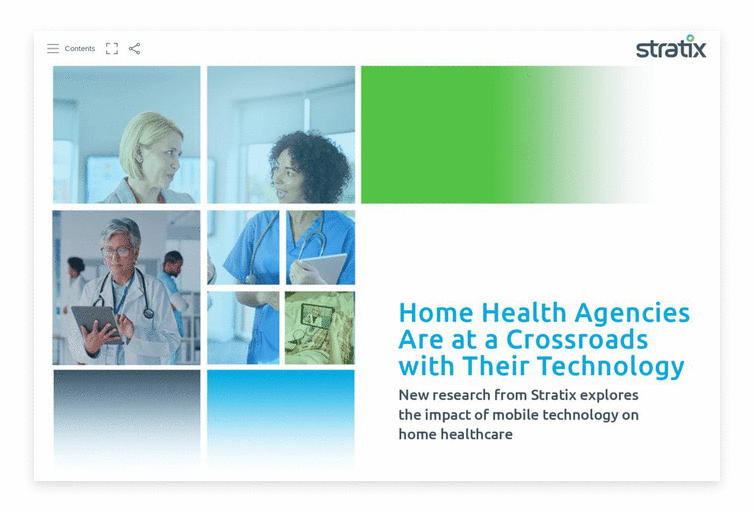8 Considerations for Choosing the Right Home Healthcare Mobile Tech
Written by Ian Slack
Blog
In the demanding world of home healthcare, mobile devices are critical to efficient care delivery. They facilitate everything from real-time communication to patient data management and navigation to appointments. However, not all devices are created equal, and choosing the right technology can significantly impact the efficiency and effectiveness of your operations. Here are the key considerations for selecting the best devices for your home healthcare provider agency.
1. Durability and Reliability
Home healthcare workers operate in dynamic environments, often traveling between appointments and handling devices frequently. This makes durability a critical factor. Look for devices that:
- Perform reliably: Devices should perform multiple tasks simultaneously without lagging or crashing, ensuring smooth workflows.
- Are built to last: Robust devices that can withstand drops, spills, and other wear-and-tear of daily use.
- Have long battery life: Caregivers need devices that last through long shifts without frequent recharging.
2. Security Features
Protecting sensitive patient data is a non-negotiable priority for home healthcare agencies. Devices must meet stringent security requirements, including:
- Data encryption: Safeguards to protect patient records and communications.
- Biometric authentication: Features like fingerprint or facial recognition for secure access.
- Remote wipe capabilities: Ability to erase data on lost or stolen devices.
- Regular updates: Devices that receive timely security updates to guard against emerging threats.
3. Ease of Use
Caregivers need technology that supports, rather than complicates, their workflows. Devices with an intuitive user interface reduce training time and increase productivity. Consider:
- Familiar operating systems: Many caregivers are already familiar with Apple’s iOS or Android, reducing the learning curve.
- Accessibility features: Tools that cater to diverse needs, such as voice-to-text, larger fonts, and easy navigation.
- App integration: Ensure compatibility with essential healthcare applications, like electronic medical record (EMR) software or scheduling tools.
4. Performance and Compatibility
Home healthcare applications often require significant processing power to function efficiently. Devices must:
- Handle resource-intensive Apps: Especially for newer technologies like AI-driven diagnostics or video consultations.
- Integrate seamlessly: Devices should work with your existing systems, such as EMR platforms, telehealth applications, and patient management tools.
- Support peripherals: Ensure compatibility with accessories like portable printers or Bluetooth diagnostic tools for added functionality.
5. Mobility and Portability
Caregivers are always on the move, making lightweight, portable devices essential. Features to prioritize include:
- Compact design: Devices that are easy to carry and use on the go.
- Strong connectivity: Support for 5G, Wi-Fi, and Bluetooth ensures caregivers stay connected no matter where they are.
- GPS capabilities: Reliable navigation to efficiently route caregivers between appointments.
6. Total Cost of Ownership
While upfront costs are important, it’s critical to consider the total cost of ownership (TCO) for your devices. Look for:
- Durability: Higher-quality devices may have a larger upfront cost but often last longer, reducing replacement needs.
- Repair and replacement support: Partner with a provider that offers rapid device replacement and repair services to minimize downtime.
- Cost-effective management: Services like Telecom Expense Management (TEM) can help reduce ongoing costs by optimizing data plans and connectivity expenses.
7. Vendor Support and Services
Selecting the right technology partner can make or break your device strategy. Comprehensive support services ensure seamless deployment and ongoing management. Consider:
- Pre-configured devices: Out-of-the-box ready devices that are kitted and configured for immediate use.
- 24/7 technical support: Access to help whenever issues arise.
- Unified Endpoint Management (UEM): Solutions that keep devices secure, updated, and running smoothly.
- Spare pool and rapid replacement: Access to spare devices and overnight replacement for damaged or malfunctioning equipment.
8. Scalability
As your agency grows, your device strategy must grow with it. Look for solutions that can scale easily, allowing you to add devices, users, and features without disrupting operations.
The Stratix Advantage
Stratix specializes in helping home healthcare agencies deploy and manage mobile technology solutions that meet these key considerations. With over four decades of experience, we provide:
- Custom kitting and deployment: Devices configured and delivered directly to caregivers’ homes, ready to use.
- Industry-leading support: 24/7 onshore technical support and rapid replacement services.
- Proactive management: Unified Endpoint Management to keep devices updated, secure, and compliant.
- Cost optimization: Telecom Expense Management to lower overall costs and maximize ROI. Our Connectivity service not only features SmartSIM technology that automatically connects caregivers to the strongest signal where they are, but pooled data saves money, too.
Conclusion
Choosing the right mobile devices for your home healthcare agency is a strategic decision that directly impacts caregiver productivity, patient care, and operational efficiency. By prioritizing durability, security, ease of use, and robust support, you can empower your team with the tools they need to succeed. With Stratix by your side, you’ll have the expertise and resources to implement a mobile device strategy that meets your current needs and scales for the future.
Ready to upgrade your mobile technology? Contact Stratix today for a consultation and see how we can help transform your home healthcare operations.

Home Health Agencies Are at a Crossroads with Their Technology
Stratix polled home healthcare leaders to see what keeps them up at night and how they address their major concerns in this research paper.
Read the Report













